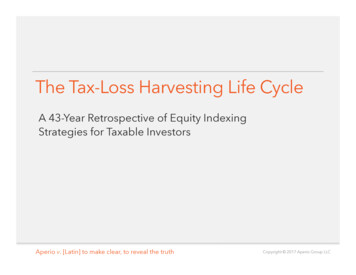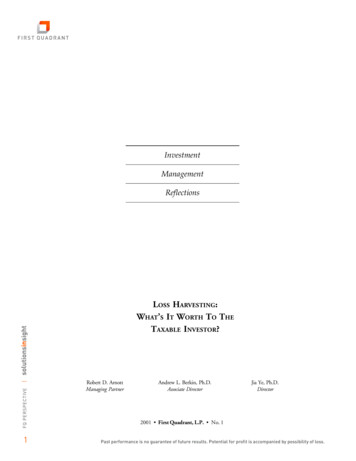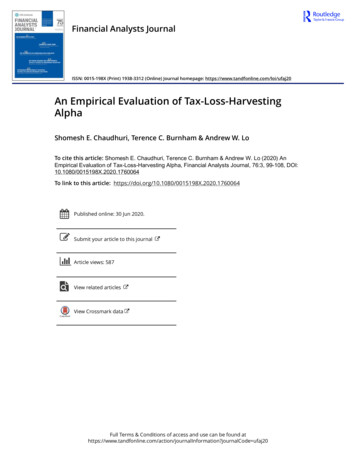
Transcription
The Tax-Loss Harvesting Life CycleA 43-Year Retrospective of Equity IndexingStrategies for Taxable InvestorsAperio v. [Latin] to make clear, to reveal the truthCopyright 2017 Aperio Group LLC1
OverviewAn Examination of Tax-Loss Harvesting Strategies1How does tax-loss harvesting ngtax-loss harvestingbeen over time?3What is the relative importance of the direct vs.deferred benefits?2
1Tax-Loss Harvesting inUS Equity Markets3
Tax-Loss HarvestingHow It Fits in a Taxable Asset AllocationIn a taxable asset allocation, a tax-loss harvesting assetclass serves to: Delay tax payments, or to avoid them entirely. Allow investors to more fully retain realizedreturns from tax-inefficient classes.US equity is a natural setting for tax-loss harvesting.4
Tax-Loss HarvestingTax-Loss Harvesting Fueled by Abundance of Losers% of Russell 3000 stocks up/down in a calendar yearSince 1998, the average % of stocks that fell was 41%100%% of Stocks / Annual Return80%60%40%20%0%-20%-40%-60%Stocks in R3000 with Positive Returns-80%Stocks in R3000 with Negative ReturnsRussell 3000 Return-100%1998 1999 2000 2001 2002 2003 2004 2005 2006 2007 2008 2009 2010 2011 2012 2013 2014 2015 2016YearNote: Data as of 12/31 of each year. Past performance is not indicative of future returns. See disclosure page for important information.5
Tax-Loss HarvestingThe Goal of Tax-Loss HarvestingThe strategy aims to realize losses on individual stocks inconjunction with an investment objective, such as: Earning index returns Tilting on quality factors Lowering carbon footprintIt materially affects return/risk profiles of standardstrategies.6
Tax-Loss HarvestingObjective, Reward, and RiskOBJECTIVEMaximize the value of losseswhile generating index-like returns.REWARDRISKHarvested losses areused to offset gainsfrom tax-inefficientasset classes—delaying or avoidingtaxes.Tracking errormanages thedivergence betweenthe tax-lossharvesting portfolioreturn and indexreturn.7
Tax-Loss HarvestingOptimal Strategy is Facilitated by Factor ModelsConstraining tracking error reduces the risk of thisstrategy. A pair of securities with similar exposures to riskfactors-such as size, valuation, or industry-tend toco-move. Quantitative tax-loss harvesting replaces a loser witha security that has similar exposures. This keeps tracking error in check.8
Tax-Loss HarvestingHow Tax-Loss Harvesting WorksAs stocks decline in value, Aperio sells a basket of stocks torealize losses and then buys a replenishment basket ofsimilar stocks so the portfolio continues to track its index.Starting Portfolio 5.0 Million# of StocksTracking ErrorVolatilityRebalanced Portfolio 5.0 Million# of Stocks350Tracking 500.5%13.4%P/E21.1P/B2.7Top 3 SectorsTop 3 SectorsTechnology21%Financials15%Health Care13%Realizes lossesto offset realized gainsoutside the portfolioTechnology21%Financials16%Health Care13%9
2A 43-Year Retrospectiveof Return and Risk in US EquityTax-Loss Harvesting Strategies10
43-Year Back-Test StudyThe Value of Tax-Loss HarvestingTo date, most appraisals have been based on MonteCarlo simulation or individual experience.Here, we complement those perspectives with a broad,detailed historical study.We emphasize ranges of observed outcomes (asopposed to simple averages) because investors’experiences vary.We focus on a tax-loss harvesting strategy that tracks anindex.11
43-Year Back-Test StudyEmpirical Study: Rolling 20-Year StrategiesMethodology:1. Launch a tax-loss harvesting strategy in the S&P 500 eachmonth between Jan 1973-Feb 20162. Track return and risk at annual horizons as strategies evolve3. Aggregate results by horizonHorizon (years)# of Observations54681040820288Assumptions:Capital Gains RateLong-term: 23.8%Short-term: 43.4%12
43-Year Back-Test StudyPerformance MetricsTax AlphaForecast TrackingErrorTax InformationRatioThe differencebetween portfolioreturn andbenchmarkreturn after taxThe indicatorof how well theportfolio will trackthe benchmarkpre-taxThe risk-adjustedexcess return dueto loss harvesting13
Tax AlphaTax AlphaJanuary 1973 – February 1.02200.8814
Tax AlphaRegime Dependence of Tax AlphaAnnualized Returns (%)January 1973 – February 201620Index ReturnTax Alpha15Average tax alphasorted by averageindex return105012345Quintile (by 10-year index return)Quintile1AverageIndex ReturnAverageTax Alpha23453.078.86 12.91 15.18 17.752.661.801.461.251.3215
Tracking ErrorTracking Error by DateJanuary 1973 – February 2016Measured inSeptembereach yearYears2006Median 1.1220071.0720081.4820091.0720100.81Forecast pre-tax,post-trade trackingerror16
Tracking ErrorTracking Error by HorizonJanuary 1973 – February 2016YearsMedian50.68100.80201.29Forecast pre-tax,post-trade trackingerror17
Tax Information RatioTax Information RatioJanuary 1973 – February 2016YearsMedianEstate/Donation Disposition510201.731.280.8818
43-Year Back-Test StudyStudy ObservationsTax AlphaForecast Tracking ErrorTax Information Ratio Over the life cycle,cost basis decreasedand prices increased,leading to loweralpha at longerhorizons. Tracking errorshowed strongdependence onmarket volatility. Tax information ratioswere uniformlypositive at allhorizons. It had a discernabledrift, by an average of0.28 basis points/month or 0.67% over20 years. The median value a20-year horizon was0.88, which comparesfavorably with topquartile activemanagers. At a 10—year horizon,tax alpha wasuniformly positive forthe 408 strategies. On an annualizedbasis, tax alpha wasgreatest in turbulent& declining markets. The smallest valuethat we saw at anyhorizon was 0.30.19
3Direct and DeferredComponents of Tax Alpha20
Direct & Deferred BenefitsHow Important are Direct vs. Deferred Benefits?Tax-loss harvesting provides benefits through bothimmediate reduction in tax liability (direct) and the timevalue of postponing tax liability (deferred). Direct: Accumulated tax savings when capital gainsare offset with harvested losses Deferred: Reinvestment of tax savings** This includes the difference in return between the portfolio and its benchmark.21
Direct & Deferred BenefitsAverage Direct and Deferred ComponentsMonthly Start DatesJanuary 1973 – February 2016Estate/donation dispositionThe average path illustrated in this slide may not berepresentative of individual experiences.22
Direct & Deferred BenefitsDirect and Deferred Benefits: Bull MarketJanuary 1973 – February 2016Inception: January 1980Estate/donation dispositionThe silhouette of this particular path bears strong resemblance tothe average experience shown on the previous slide.23
Direct & Deferred BenefitsDirect and Deferred Benefits: Bear MarketJanuary 1973 – February 2016Inception: January 1980Estate/donation dispositionThis silhouette of this particular path differs materially from the average.24
Summary25
SummarySummary1How does tax-loss harvesting work?A tax-loss harvesting asset class allows investors to: more fully retain realized returns from tax-inefficient classes delay tax payments, or to avoid them entirely.An abundance of losers makes U.S. equity a natural setting fortax-loss harvesting.Optimal tax-loss harvesting is facilitated by factor models.26
SummarySummary2How effective has tax-loss harvesting been over time?Tax AlphaForecast Tracking ErrorTax Information Ratio Was uniformlypositive at a 10year horizon forthe 408 strategies Was sensitive tomarket conditions Was uniformlypositive at allhorizons Was higher inbear markets Drifted by 0.28basis points/month on average,or 0.67%over 20 years Had a medianvalue of 0.88 at a20-year horizon,which comparesfavorably with topquartile activemanagers27
Summary3What is the relative importance of the directvs. deferred benefits?Tax-loss harvesting provides benefits through both immediatereduction in tax liability (direct) and the time value ofpostponing tax liability (deferred). Benefits vary depending ontime horizon and market conditions.Conditions that Provide Greater ValueTime HorizonMarket ConditionsDirectEarlier in life cycleTurbulent, declining marketsDeferredLater in life cycleCalm, upward-trending markets28
SummaryExecutive SummaryTax-loss harvesting allows investors to more fully retain realizedgains from tax-inefficient classes by delaying or avoidingpayments.At a 10-year horizon, tax alpha was uniformly positive for the408 strategies tested, and higher in bear markets.The direct and deferred benefits vary depending upon timehorizon and market conditions. Direct provides more valueearly and in bear markets. Deferred benefits are seen morelater and in bull markets.Investor experiences vary. However, despite the variation, taxaware investing pays off for the taxable investor.29
Research AuthorsLisa Goldberg, PhD is Aperio Group’s Director of Research. Complementing her work at Aperio Group,Goldberg continues as a faculty member at the University of California, Berkeley, where she serves as CoDirector of the Consortium for Data Analytics in Risk (CDAR). Prior to joining Aperio Group, Lisa was anExecutive Director of Research at MSCI, where she directed research supporting asset managers, pensionfunds, endowments, and sovereign wealth funds, with an emphasis on risk due to extreme events, assetallocation, and credit. She holds a BA in Mathematics from the University of Rochester and a PhD inMathematics from Brandeis University. In addition to her role at CDAR, Lisa is Adjunct Professor of Economicsand Statistics at UC Berkeley. She has also held academic positions at City University of New York, the Institutefor Advanced Study, l’Institut des Hautes Études Scientifiques, and the Mathematical Sciences ResearchInstitute. Lisa serves on the editorial board of the Financial Analysts Journal, and she is an expert judge for theHaas Business School’s Moskowitz Prize for Socially Responsible Investing.Peter Hand is Aperio Group's Director of Quantitative Strategies. He began his career at Barclays GlobalInvestors (BGI), where he worked in a number of different capacities. As head of research for the definedcontribution group, Pete built the models for the 40 billion LifePath Fund complex and developed the firsttarget date fund with an annuity option. He was also research officer for BGI’s flagship global macro hedge fundand was director of the client solutions group, where he developed customized structured products forinstitutional investors and co-developed the KLD socially responsible iShare. Immediately prior to joiningAperio, Pete was the outsourced CIO for a multi-billion dollar wealth advisory firm serving ultra-high-net-worthfamilies, where he focused on after-tax asset-allocation models. Pete received his BA in economics and politicsfrom Princeton University. He has traveled extensively, including teaching economics in Kazakhstan and servingas a technical assistance volunteer in Bosnia, Albania, and Morocco.Alan Cummings is the Chief Systems Architect at Aperio. He is responsible for the design and implementationof the trading, operations, and reporting systems. Alan is a former Senior Software Engineer for NationalInstruments and Senior Physicist for Honeywell-Measurex. Prior to his professional career, he was a volunteer forthe US Peace Corps at the A.D. Patel College, Fiji Islands, where he taught high school math and physics. Alanreceived his PhD in Physics and Master of Financial Engineering degrees from the University of California,Berkeley.30
AppendixDisclosureThe information contained within this presentation was carefully compiled from sources Aperio believes to be reliable, but wecannot guarantee accuracy. We provide this information with the understanding that we are not engaged in rendering legal,accounting, or tax services. In particular, none of the examples should be considered advice tailored to the needs of any specificinvestor. We recommend that all investors seek out the services of competent professionals in any of the aforementioned areas.The performance reflected in the tables and charts in this report are hypothetical, shown for illustrative purposes only, and notbased on actual investments. Furthermore, they do not reflect the deduction of any management fees, which would lowerperformance returns. The performance does include 0.06% one-way transaction costs (4bps one-way spread 2bps in tradingcosts).The use of hypothetical performance has significant limitations, some of which are described below.Back-testing involves simulation of a quantitative investment model by applying all rules, thresholds, and strategies to ahypothetical portfolio during a specific market period and measuring the changes in value of the hypothetical portfolio basedon the actual market prices of portfolio securities. Investors should be aware of the following: 1) Back-tested performance doesnot represent actual trading in an account and should not be interpreted as such, 2) back-tested performance does not reflectthe impact that material economic and market factors might have had on the manager’s decision-making process if themanager were actually managing client’s assets, and 3) there is no indication that the back-tested performance would havebeen achieved by a manager had the program been activated during the periods presented above. For back-testedperformance comparisons, the benchmark returns are simulated using historical constituents’ weights and total returns.The Russell 3000 Index is an equity benchmark for US stock performance. It is a capitalization-weighted index covering thelargest 3,000 publicly-traded US stocks. The index represents approximately 98% of the total market capitalization of the USstock market.The S&P 500 Total Return Index is an unmanaged group of equities representing the large-cap sector of the US domesticmarket. Index returns reflect reinvestment of dividends but do not reflect fees, brokerage commissions, or other expenses ofinvesting.With respect to the description of any investment strategies, simulations, or investment recommendations, we cannot provideany assurances that they will perform as expected and as described in our materials. Past performance is not indicative of futureresults. Every investment program has the potential for loss as well as gain.31
A tax-loss harvesting asset class allows investors to: more fully retain realized returns from tax-inefficient classes delay tax payments, or to avoid them entirely. An abundance of losers makes U.S. equity a natural setting for tax-loss harvesting. Optimal tax-loss harvesting is facilitated by factor models.










